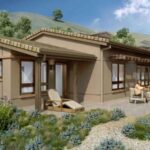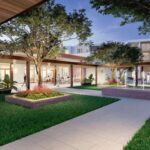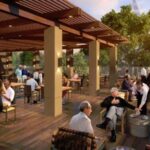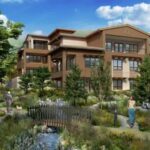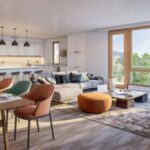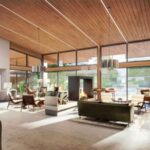How to design homes for life well beyond 100

LONDON: The world is getting older. By 2050, the global population of people in their 80s will be three times what it is today. According to the Stanford Center on Longevity, half of all the 5-year-olds currently living in the U.S. can expect to make it into their 100s. Harvard Medical School aging researcher David Sinclair suggests that the first person to live to age 150 has already been born.
It’s too early to predict all the ways that longer lives will change society, but at least one industry is starting to make some guesses. The developers, designers, and operators of senior housing are thinking about and planning for how these demographic shifts will affect their businesses and the services they provide.
To get ahead of the curve, some are designing their facilities for people who will technically be seniors for more than 40 years. They’re learning from communities around the world where people tend to live the longest and reconsidering the golf courses and bingo halls that were once central leisure activities. They’re also trying to design features that enable people to be healthy and active as long as possible.
It’s a dramatic change from the last-stop nature of retirement communities of the recent past. If people will soon be living many more years in homes and communities long assumed to have a quick turnover, the way these spaces are planned and built will have to change.
Designing to live longer
Senior housing is already a diverse industry, with distinct segments catering to different age groups and health conditions. There are the 55-plus and active adult communities where golf, pickleball, singles scenes, and even Jimmy Buffet-inspired lifestyles are main draws. Others are more focused on healthcare for the aging, including assisted-living developments that have moderate levels of in-community or in-home care, and memory care facilities that have live-in staff. There’s even a growing number of so called life-plan communities that offer all tiers of independence and care within the same space.
Many expect the industry to get more diverse in its offerings as the pool of older people grows and their lives last longer. One new offering that could emerge to meet the demographic shift is multigenerational senior housing.
“There might be a 100-year-old, an 80-year-old, and maybe a 60-year-old all from the same family, all living in the same environment,” says Joe Hassel, senior living leader at Perkins Eastman, an architecture and design firm with offices around the world.
Hassel says his team has been studying what are known as Blue Zones, or places around the world that have high rates of people living long, healthy lives. Ranging from Okinawa, Japan, to Sardinia, Italy, these places share several characteristics that seem to influence longer living. Some are related to physical activity and diets of fresh food; others are related to community and social elements, from having regular contact with neighbors to a kind of ingrained happy hour that Blue Zones researchers call “Wine at 5.”
“The environment supports healthy eating, active fitness, and community involvement. So we want to take those key definitions of why those environments are successful and why people are aging into their 100s and figure out how to replicate them,” Hassel says.
His firm has several projects that try to do that. One is an expansion of a continuing-care retirement community in Fairfield, California, called Paradise Valley Estates, where residents have access to in-home care as needed. The expansion focuses on improving the walkability of the community, both in terms of the layout and walking paths but also its accessibility to the kinds of amenities and places people want to go.
“You come from your apartment home or your garden home or cottage and you can walk to the store or walk to different restaurants,” Hassel says.
He notes that the model for these communities is starting to change from an insular layout to one that’s more connected.
“In today’s senior living communities, everything’s concentrated in a town center as they call it, and everyone comes to that destination and then goes back home,” Hassel says. “I think looking at how that’s deconstructed in an actual urban environment will be a really important factor in terms of how we enhance movement in the communities we create in the future.”
The design of senior dwelling spaces is also being rethought. Sol on Park is a 200-unit affordable senior housing project expected to open in 2027 in New York City, and the developers behind it have focused on creating diverse spaces throughout. The studio apartments will be compact in size, but architect Brian Loughlin of Magnusson Architecture and Planning says they’ve been designed with alcoves and nooks that offer a bit more variety than a typical boxy studio.
“Especially as people are aging in place longer, they’re going to be spending a lot more time in these units,” Loughlin says. “So we’re not thinking of this as a 5- or 10-year solution but potentially a 20- or 30-year solution. How do we bring as much quality into that space as possible?”
Loughlin says the design also focuses on spaces that might easily be overlooked, like hallways. Small recesses are being added to each unit’s front door to break up the monotony of the hallway and create a small personal space where residents may interact. The design also adds large windows and small gathering spaces at the end of each hallway to give residents a view and an area for the kind of casual neighborhood interactions that might otherwise happen on the sidewalk.
“It’s a nice opportunity for people to connect with their neighbors and the neighborhood around them,” Loughlin notes.
Community centered
The Centers for Disease Control and Prevention recently named social isolation and loneliness key risk factors for declining health in older adults. That recognition has underscored the importance of building social space into housing meant for that demographic. At Sol on Park, the idea goes beyond the simple community rooms or clubhouses that exist in many senior housing projects today.
“The old model was really tight [residential units] on top of one common room at the bottom,” Loughlin says. The Sol on Park design interprets community space more broadly, scattering it in various shapes throughout the 15-story building.
“We tried to really layer those spaces in, so that folks don’t just take the elevator up and down but . . . think I can get off on the fifth floor and go to the terrace, or go to the roof and see the garden,” Loughlin says. “It’s almost like a vertical neighborhood.”
Having the CDC recognize these issues has been crucial, Loughlin says, noting, “Once that was a data point that we could bring to developers, we could say your residents are going to live longer if we can provide opportunities to socialize not just in common areas on the ground floor but throughout the building.”
One of the developers behind the Sol on Park project, Selfhelp Realty Group, was very open to these kinds of design interventions. The organization, which focuses partly on providing affordable housing for survivors of the Holocaust, has conducted its own research into design factors that help people live longer and healthier lives. The research showed that the organization could develop units and community spaces that prioritize social interaction without busting its project budgets, even in complicated public-private partnerships with the city, such as Sol on Park.
“We’re hoping this becomes a model where people say, ‘Okay, if they could do it in this space with all these restrictions and it’s thriving,’ then that will also create opportunities for other developers who [have previously not been] open to these kinds of designs or this kind of activation,” says Mohini Mishra, housing program director at Selfhelp Realty Group. “We know this model works.”
Beyond golf
In Sonoma County, California, a new kind of senior community is being built. There’s no golf course, pickleball court, or bingo hall. Instead, there’s a meditation hall, a yoga studio, and a suite of classes focused on mindfulness and contemplative care. Enso Village, slated for completion next summer, is a Zen-inspired senior housing project created by the San Francisco Zen Center and Kendal, a developer founded on Quaker principles. Compared to the golf course communities that proliferated across the Southwest, Enso Village points to a more diverse new breed of activity-focused senior communities.
Hassel of Perkins Eastman says he’s seeing more projects follow this type of affinity-focused model. “The old school of the bingo days has certainly evolved,” he says. “These types of communities—in terms of who we connect with and how we create these active vibrant environments with people who share our values and our interests—will need to vary dramatically. And the scale will probably be smaller than the mega-communities of today.”
They may also be more integrated into society. Another Perkins Eastman project is Choice in Aging, in Pleasant Hill, California, where senior housing is being colocated with a Montessori preschool. Residents can participate in a day program that overlaps and interweaves with the preschool’s activities, giving young and old an opportunity to interact. It’s similar to age-spanning housing projects in places like the Netherlands where university students can live rent-free in senior housing.
The idea is that each group will benefit from exposure to the other, and intergenerational learning and understanding will ensue. These programs also counter social isolation by giving older adults a more diverse array of people to interact with.
In the U.S., most senior housing is still just that: housing for seniors only. The need for these types of facilities is growing, according to Adam Cohan, who leads national active adult living strategy for the rental housing giant Greystar. The company has acquired or developed more than 10,000 units of senior housing around the U.S., and Cohan says the demographics suggest it will be a growth sector for the foreseeable future.
“It comes up at every senior housing conference or meeting,” he says. “People just keep getting older.”
And not all of them can afford to live in an assisted-care facility with monthly rents around $5,000 or to buy into a bespoke Zen retirement community. “The bulk of demand is definitely at a lower price point,” Cohan says. “I think first and foremost that’s what we’re trying to solve, is people that want to move out of their home but can’t necessarily pay that much.”
With rents that are closer to $2,000 per month in many markets, Greystar is focused on providing active adult housing, with some community assets like gyms and large clubhouses but few healthcare services. In New York, the Sol on Park project has an even lower price point, with subsidized units catering to the many people for whom $2,000 is still far from affordable. But in terms of equitable living for lower-income seniors, major gaps persist.
Cost issues are also influencing the way some unconventional senior housing projects take shape. Hassel at Perkins Eastman points to projects that are based on a cohousing model, where like-minded people choose to share common areas in a semiprivate collective home. It’s a housing type that’s seen increasing investment from startups, though these projects tend to be geared toward young, globetrotting professionals. Cornerstone Village Cohousing, an intentional community in Cambridge, Massachusetts, is one example of a project where seniors are integrated into a cohousing living arrangement.
Technology may also be making it easier for senior housing to work for people as they age into their 100s. “Home health opportunities, telemedicine, and technology will have a huge impact on how people age outside of traditional senior living communities,” Hassel says.
Cohan says some Greystar residents do hire in-home care in order to avoid having to move into another facility. And for the company’s part, designing amenities that encourage active living and social interaction are part of keeping residents healthier longer.
As an owner-operator of senior housing, Cohan says it’s in Greystar’s financial interest to design with residents’ health in mind. After all, lower turnover means lower costs. He says the company will continue to invest in design elements that promote maintaining a healthy lifestyle, from walkable neighborhoods to active clubhouse spaces that are programmed for regular social gatherings.
All of these efforts are undoubtedly part of a larger business model, but they’re also a response to the very real needs of people who are expected to live much longer lives. Cohan says the demographic trends are clear in Greystar’s portfolio: The average age of residents in some of its communities has already increased.
“I think we will see residents stay 10-plus years,” Cohan says. “If we’re really bringing the focus on health and wellness, then people will just not need the next level of care and they will stay with us longer. And that means we’re doing a good job.”
- Paradise Valley Estates in Fairfield, California.
- Inspirata Pointe at Royal Oak in Sun City, Arizona.
- Inspirata Pointe at Royal Oak
- Paradise Valley Estates in Fairfield, California.
- Paradise Valley Estates.
- Enso Village in Healdsburg, California.
- Enso Village.
